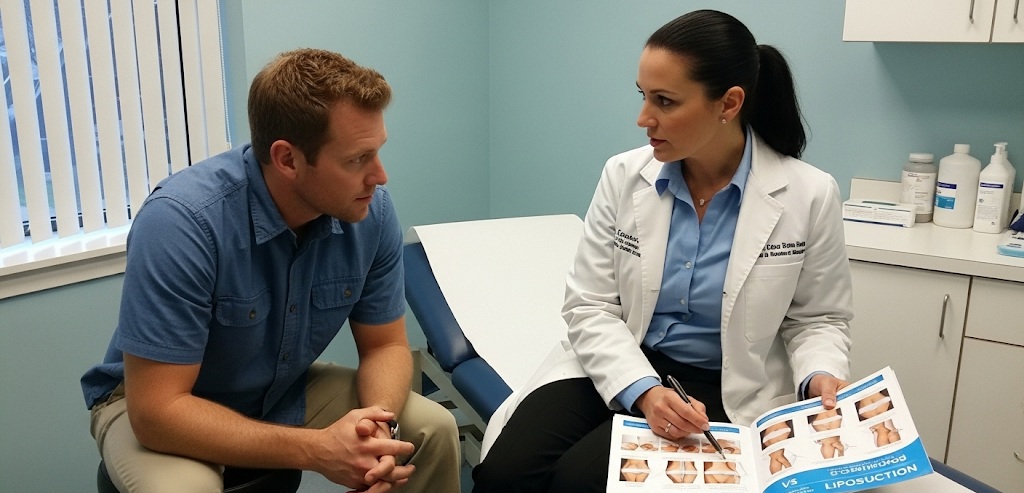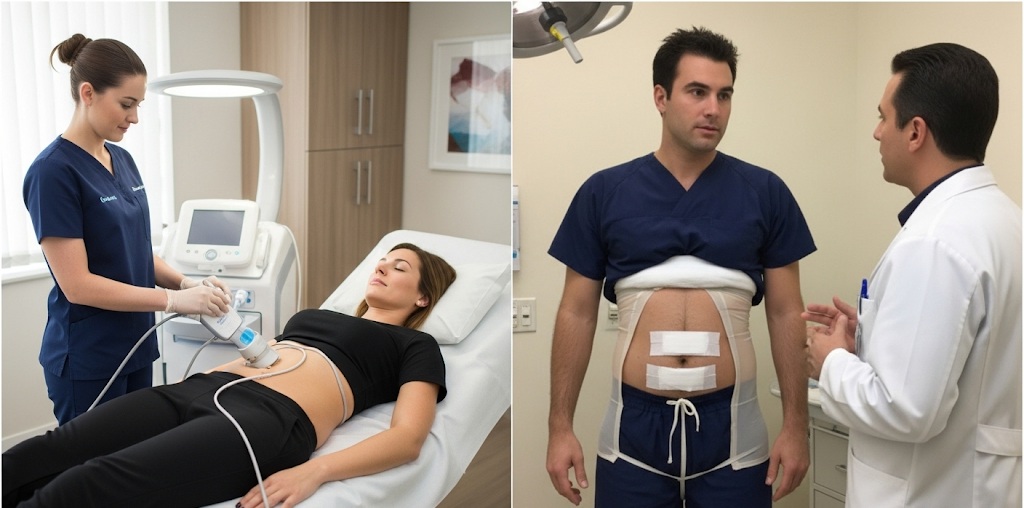A few days before her liposuction procedure, one of my patients texted me a photo from a med spa she’d visited. The sign read: “Easy, non-surgical fat removal with CoolSculpting.”
“Is this better than liposuction?” she asked.
We had already discussed her case in detail, and she was leaning toward Lipo 360. But I understood her hesitation completely. The promise of something simpler, with no downtime and no pain, is tempting.
We talked briefly about how Coolsculpting compares to liposuction, but went deeper during her consultation in my office. I told her all that I am about to tell you now.
What Is CoolSculpting?
CoolSculpting is a brand-name fat reduction treatment that uses a process called cryolipolysis. It’s basically freezing fat cells until they die, and letting the body naturally flush them out.
We’ve explained the science in detail in our post about what cryolipolysis is, but here’s the quick version: cryo means cold, and lipolysis means breaking down fat. So, cold fat breakdown — that’s fat freezing in its simplest form.
CoolSculpting is non-invasive, FDA-cleared, and has been around for over a decade. It’s quite a simple procedure, and a session usually takes about 45 minutes. The Coollspulting device uses applicators (pads that deliver controlled cooling) on targeted areas like the chin, abdomen, or arms.
Good candidates for this fat reduction treatment are patients with good skin elasticity and minimal stretch marks, since the skin will retract after fat cells are reduced.
One thing worth noting: not every fat freezing treatment is actually CoolSculpting. Some providers use different machines that aren’t FDA-cleared, and they don’t go through the same quality standards or the specialized training programs from Zeltiq Aesthetics (the company behind CoolSculpting). This is important, because the safety and effectiveness of non-branded devices can vary a lot.
And while the technology matters, the provider matters even more. Just like with liposuction, the skill and experience of the person performing your treatment can make a huge difference in your results.
What Is Liposuction?
Here’s what I tell patients when we talk about liposuction results: it’s a minimally invasive fat removal procedure, with a short recovery time. These days, most surgeons (myself included) perform it without general anesthesia.
Liposuction works by making two tiny incisions and inserting a thin tube called a cannula to gently remove fat. We can target those stubborn areas that diet and exercise never seem to touch — like the abdomen, flanks, thighs, chin, or arms.
In summary: liposuction has the benefits of a short recovery time of about two to three months, and offers realistic outcomes.
One of today’s most advanced techniques is Liposucción VASER. Think of it as the opposite of fat freezing: instead of cold, it uses controlled heat through ultrasound-assisted lipolysis to break down fat cells. A specialized probe emits ultrasonic energy to gently melt the fat, making it easier to remove.
Because VASER liposuction minimizes damage to surrounding tissues, it’s more precise, less traumatic, and often more comfortable for the patient. It’s also how we achieve HD liposuction results: sculpting defined, athletic contours with shorter downtime compared to traditional methods.
CoolSculpting vs Lipo: Head-to-Head Comparison
So as you can see, Coolsculpting vs liposuction work in very different ways, and that difference shows in their results.
For both procedures, it’s important to know they’re not designed for weight loss. The best candidates are already close to their ideal body weight and want to target stubborn fat pockets that just won’t go away with diet and exercise.
Here is a short comparison between Coolsculpting vs. liposuction: How both procedures work, their results and recovery timelines:
CoolSculpting vs Liposuction Comparison Table
| Factor | Coolsculpting | Liposucción |
| Fat Reduction Device | Applicator pads that freeze fat cells so the body can naturally eliminate them over time. | Cannula to extract fat cells. HD VASER adds an ultrasound probe for precision heat. |
| Invasiveness | Non-invasive; no incisions or anesthesia | Minimally invasive; tiny (2mm) incisions, local anesthesia used. |
| Results | Subtle, gradual fat reduction | High-definition and precision contouring, targeting specific fat deposits. |
| Pain | Mild discomfort (cold, tingling, numbness during/after treatment). | Mild to moderate soreness, swelling, or bruising after surgery. |
| Recovery Time | No downtime; resume normal activity the same day. | Short recovery; 2 to 5 days rest recommended for best healing. Requires wearing garments. |
| Cost | May require multiple sessions; cost can add up | One-time procedure; may be more cost-effective in the long run |
| Results Timeline | Gradual results over 2–3 months | Noticeable changes in 3 weeks; continued improvement over 2–3 months as swelling subsides. |
| Risk Factors | Side effects like paradoxical fat growth in some cases | Small risk of infection or fluid buildup. |
In summary: CoolSculpting offers non-surgical fat removal with no downtime, but the changes are more subtle and gradual. Liposuction is minimally invasive, requires only a short downtime, and delivers more dramatic, precise results in a single treatment.
So now, here comes the big question…
What’s Right for You?

The ideal candidate for either CoolSculpting or liposuction is someone who’s already close to their ideal BMI. These are typically active, health-conscious people who eat well, exercise regularly, but still can’t get rid of stubborn fat in certain areas.
Why does this happen? Our bodies naturally store fat in specific spots, and sometimes no amount of cardio or clean eating will change that. What we do in cosmetic surgery is reduce the number of fat cells in those targeted areas, reshaping the contour to match your goals.
So, how do you decide between CoolSculpting and liposuction? Of course, the procedure and technology matter — but I believe the more important factor is who performs it.
CoolSculpting is a non-surgical procedure, so it’s often offered in med spas or clinics by professionals who may not be board-certified cosmetic surgeons. That’s why my first recommendation is always to check your provider’s credentials. Are they certified by a recognized medical board? Do they have extensive training in body contouring?
Liposucción, on the other hand, is a surgical procedure that must be performed by a licensed physician. Board-certified cosmetic surgeons are MDs who have completed rigorous training, follow strict safety standards, and have the experience to tailor results to your unique anatomy.
Choosing a certified provider isn’t just about a title. It’s about your safety, your comfort, and the quality of your results.
Let’s now address another common concern:
Why is PAH a possible Coolsculpting side effect?
PAH stands for paradoxical adipose hyperplasia, or simply, paradoxical fat growth. It’s a rare condition where the frozen fat cells, instead of dying and being eliminated from the body, actually enlarge and remain.
In other words, PAH is the exact opposite of what CoolSculpting is meant to achieve. It can create a firm, visible bulge that feels out of place. It doesn’t appear right away — it typically develops over the following months — and scientific studies suggest it’s often underreported by patients.
So, what happens if CoolSculpting results in PAH? The good news is, there’s a solution. In most cases, HD VASER liposuction can successfully remove the affected fat and restore a smooth, natural contour.
The Role of Regenerative Medicine in Body Treatments
When comparing CoolSculpting vs liposuction, I also like to think about each treatment’s potential. CoolSculpting — while non-invasive and effective — still requires time for results to fully develop more predictable results.
Liposuction, of course, has its own challenges. But health technology is constantly advancing to make it even better — reducing downtime, swelling, and discomfort. Techniques like Liposucción VASER are proof that we’re on the right track.
If you’ve been following my podcast Late Nights With Dr. G, you know I’m deeply interested in regenerative medicine. To me, it’s the future of healthcare; and not just for aesthetics, but for overall healing.
Here’s where liposuction connects to that future: the fat we remove during liposuction contains adipose-derived stem cells. These cells can be harvested, processed, and re-injected to help regenerate tissues — whether that’s enhancing cosmetic results, supporting recovery from sports injuries, or even contributing to treatments for serious conditions.
One case that stuck with me came from the NYU Langone Orthopedic Digital Library. They took stem cells from an athlete’s own fat, processed them, and re-injected them into his knee to treat osteoarthritis.
Those imaging studies afterward were incredible — showing measurable healing and improvement. In part, that’s when I decided to bring regenerative treatments here to True Contour.
CoolSculpting has taught us a lot about how the body responds to fat reduction, and researchers are still studying why rare responses like PAH occur. Liposuction, meanwhile, continues to expand its potential — from simple fat removal in the ’90s, to fat transfer for contouring, and now to regenerative applications that help the body heal from the inside out.
How To Choose The Best Fat Reduction Treatment
Cosmetic surgery has come a long way. Whether it’s CoolSculpting or liposuction, each procedure has its own pros and cons, different techniques, recovery timelines, and results.
But the most important factor? What these treatments can do for you.
It’s always better to get advice from a board-certified cosmetic surgeon than to make decisions based on a sign outside a med spa. If you want to address stubborn fat pockets with precision, safety, and results you can truly see, schedule a consultation with us. We’ll talk about your body contouring goals and create a plan that’s tailored to you.
Your body deserves expertise and results you’ll love for years to come.
